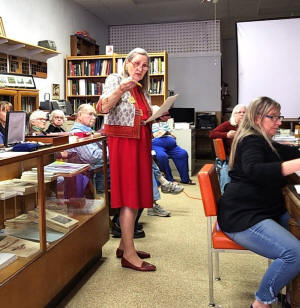|
Abbie Alexander explains the
concepts and styles of Victorian Era Jewelry at April LCG&HS meeting
 Send a link to a friend
Send a link to a friend
[April 19, 2023]
 At
the April Logan County Genealogical and Historical Society meeting,
Abbie Alexander gave a presentation on Victorian jewelry. At
the April Logan County Genealogical and Historical Society meeting,
Abbie Alexander gave a presentation on Victorian jewelry.
Diane Osborn introduced Alexander, who grew up in Lincoln and now
lives in Peoria. Alexander works with Triple A Appraisals,
appraising items like jewelry, vintage costumes, fine art and estate
sales. She has taught at Heartland Community College, the Peoria
Park District and Osher Lifelong Learning Institute at Bradley
University.
As she began the presentation, Alexander said a lot in jewelry
history helps her learn about history in general.
At some point, Alexander said many will inherit a box of jewelry and
wonder what it is. Her presentation would provide some quick answers
like when a piece of jewelry was made, who made it, what was done
with it, how much it is worth and whether it is “real” or costume.
Tools of the trade help answer some questions. For example,
Alexander said a 10-power magnifier with a light in it can help
people see the markings that determine what the piece is made of.
She said semi-chrome polish is the best polish for jewelry.
On costume jewelry called Bakelite, Alexander said you can take a
tiny dab of pink paste and put it on the jewelry. If you take a
white cloth and it turns from pink to yellow, you can test the
chemical composition. Vinegar, nitric acid and diamond testers are
other tools of the trade.

When you use a diamond tester, Alexander said the
light in the tester turns to red if it is cubic zirconia, a piece of
glass, or a Yag stone. [Yag is a synthetic crystal of yttrium
aluminum garnet used as imitation diamond.] Another easy way is to
take a diamond and blow on it. She said if it clears up to be
fog-free, it is a real diamond.
A pennyweight shows how much gold is in the jewelry.
Alexander said it is measured in grams, pennyweights and ounces. She
looks at the KITCO website to see how much the gold is worth.
For repairing jewelry, Alexander said E6000 is the best glue.
In the class Alexander teaches for the Peoria Park District and
Bradley’s OLLI program, she starts with Victorian jewelry. In other
sections, she discusses Edwardian, Art Deco, Art Nouveau, costume
jewelry and a glossary of terms.
The Victorian Era was started by Queen Victoria. Queen Victoria
married Prince Albert, who was very interested in the arts.
Alexander said Prince Albert encouraged people in his country to
start being creative and invest in the art world. Prince Albert
designed Queen Victoria’s engagement ring, which was a snake with
its tails in its mouth.
Queen Victoria had nine children and Alexander said the queen would
save their baby teeth when they fell out. Queen Victoria would have
the teeth placed in jewelry.


One photo Alexander showed had Victorian jewelry
examples of a snake and a pin with a baby tooth on it.
In Queen Victoria’s crown, Alexander said there was a 180-carat
diamond. The diamond had a curse on it and was cut down to 106
carats.
When Prince Albert died, Queen Victoria was very upset. Alexander
said she began wearing black mourning jewelry. Wearing white pearls
was not allowed.

The black gemstone jet had long been used in jewelry.
The jet was mined underneath the ground in Whitney, England.
Alexander said jet became rare after people stopped mining it for
fear the whole town of Whitney would fall in.
French jet was suitable for mourning jewelry. Alexander said it was
neither French nor jet but was black bead glass.
Taking a piece of concrete and raking the jewelry across the
concrete is the way Alexander said someone could find if something
was real jet. If it leaves a black line on the concrete, it is real
jet. French jet would break apart.
Next, Alexander showed several photos with examples of Victorian
jewelry popular between 1840 and 1889. Alexander became interested
in Victorian jewelry after reading about it in the Antiques Journal
when she was younger.

At a home show in Peoria, Alexander met C. Jeanenne
Bell, who wrote the book Answers to Questions About Old Jewelry.
Alexander has gotten much of her knowledge about jewelry from this
book and bases her lectures on it.
Bell is also an appraiser on the Antiques Road Show. From Bell,
Alexander found out a diamond stone she had melted down to put in a
necklace was not a diamond but a Yag stone.
The Victorian era was a time of Egyptian revival and Alexander said
Egyptian motifs became popular in jewelry.
Ladies of the era often wore Chatelaine, which Alexander referred to
as a ladies’ tool belt. This tool belt women wore on their waist
held small keys to wind clocks, a screwdriver, nail file, and other
items a lady might need.
Because Queen Victoria was of Scottish descent,
Alexander said Celtic jewelry became collectible and desirable
during the Victorian era. These included sash pins and Celt pins.
Hair jewelry was also popular. To make hair jewelry, Alexander said
the hair was boiled in soda water then weighted with fishing weights
around the table. There were patterns for weaving the hair, and
woven hair was often used to make watch chains.
Gutta Percha is black or brown, so Alexander said it was appropriate
for mourning jewelry. Lockets, broaches, bracelets, canes and even
tooth fillings were made from Gutta Percha.
[to top of second column] |


A Claddagh ring is one Alexander said was created by
an Irish man looking for an engagement ring. This ring has a crown
symbolizing loyalty, hands symbolizing friendship and a heart
symbolizing love.

Cameos were another popular item during Queen
Victoria’s reign. Pope Leo the Twelfth opened a school for cameo
engraving and carving to teach parishioners how to make money for
the parish. Alexander said they would use onyx, agate, sardonyx,
carnelian, coral, lava, jet and conch shells from the ocean to carve
cameos.
The genre cameo depicts life in the world, and Alexander said these
types are rare. Roman mother cameos that depict a silhouette of a
woman were not as popular.
Lava cameos made from lava are the ones Alexander said are the
rarest and most expensive.
Intaglio, another jewelry design, is the opposite of a cameo in the
way it is made. With Intaglio, Alexander said the design is carved
into the item [below the stone’s surface].
There were several pieces of jewelry Alexander brought to show
everyone.

Pinchback, which Alexander bought in Canada, is
artificial gold. Alexander said this artificial gold jewelry is
named after its maker.
Alexander showed some coral jewelry and said coral is now rare
because of greed. A coral piece set in 14 carat gold is worth about
$3000.
If something is made of branch coral, Alexander said is it worth
around $400. These look like the branches of a coral plant, are
orange and are strung together in graduated style.
Coral was used for jewelry because it was thought to bring good
luck. Alexander said coral teething rings were made for children.
Amethyst is one of Alexander’s favorite gems and she had an amethyst
ring designed in memory of her Aunt Mildred. Alexander also showed a
Celtic sash pin made of a light amethyst. Alexander said amethyst
was acceptable for mourning during the Victorian Era. Large amethyst
jewelry can be valuable.

Pietra Dura is a type of inlay. It is durable and of
the earth. Alexander said it is a hard stone.
Some jewelry is made using a technique called Taille d Epergne.
Alexander said that is an enameling technique in which the gold is
dug out and filled with black enamel.
Another piece Alexander showed was a dog tag popular in England [not
the ones used in the armed forces]. She explained the hallmarks on
it and gave everyone a handout with a chart showing how to find
hallmarks.

On the dog tag, Alexander said the top hallmark shows
RC, which is the metal crafter where it was manufactured. The second
hallmark shows the city of origin, which is Sheffield, England. The
third one shows a walking lion, which means it is sterling silver.
The fourth hallmark is a calligraphy font representing the year it
was made, which was 1977. The final hallmark shows Queen Elizabeth’s
profile. Alexander said 1977 was Queen Elizabeth’s Jubilee.

The last few pieces Alexander showed were made of
jet, garnet, cubic zirconia and opal. She said garnet has been used
to make bullets because it is heat seeking.
With cubic zirconia, Alexander said a black line on a piece of white
paper will be visible. If it is a real diamond, the line cannot be
seen because the density of the diamond sends the image to another
plane.
A black opal Alexander has come from Australia. She said because
opals are very fragile, they are glued to a piece of obsidian.
Alexander had the jewelry designer cover the obsidian with gold. Her
floating opal has chips of opal floating around in oil.

Alexander’s Micro Mosaic jewelry is made from tiny
pieces of colored tile. She said this jewelry was popular during the
Victorian Era.
Banded agate is a big black and white stone. Alexander said the
cameo was carved out of the white and the black serves as the
background. These were the final pieces Alexander showed.
After the presentation, Alexander offered to appraise jewelry people
had brought with them.
At the LCGHS meeting Monday, May 15, several area fifth grade
students will share the history of the Civil War character they
learned about for the Civil War Walk earlier in the month.
[Angela Reiners] |